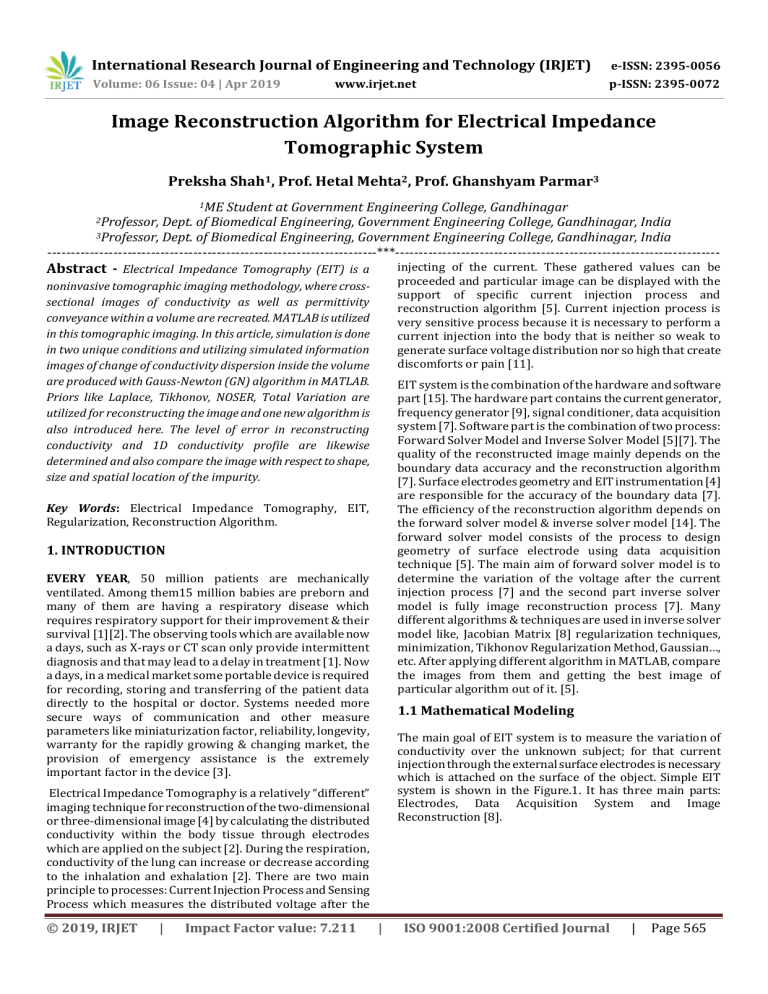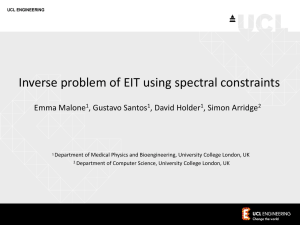IRJET- Image Reconstruction Algorithm for Electrical Impedance Tomographic System
advertisement

International Research Journal of Engineering and Technology (IRJET) e-ISSN: 2395-0056 Volume: 06 Issue: 04 | Apr 2019 p-ISSN: 2395-0072 www.irjet.net Image Reconstruction Algorithm for Electrical Impedance Tomographic System Preksha Shah1, Prof. Hetal Mehta2, Prof. Ghanshyam Parmar3 1ME Student at Government Engineering College, Gandhinagar Dept. of Biomedical Engineering, Government Engineering College, Gandhinagar, India 3Professor, Dept. of Biomedical Engineering, Government Engineering College, Gandhinagar, India ----------------------------------------------------------------------***--------------------------------------------------------------------2Professor, Abstract - Electrical Impedance Tomography (EIT) is a injecting of the current. These gathered values can be proceeded and particular image can be displayed with the support of specific current injection process and reconstruction algorithm [5]. Current injection process is very sensitive process because it is necessary to perform a current injection into the body that is neither so weak to generate surface voltage distribution nor so high that create discomforts or pain [11]. noninvasive tomographic imaging methodology, where crosssectional images of conductivity as well as permittivity conveyance within a volume are recreated. MATLAB is utilized in this tomographic imaging. In this article, simulation is done in two unique conditions and utilizing simulated information images of change of conductivity dispersion inside the volume are produced with Gauss-Newton (GN) algorithm in MATLAB. Priors like Laplace, Tikhonov, NOSER, Total Variation are utilized for reconstructing the image and one new algorithm is also introduced here. The level of error in reconstructing conductivity and 1D conductivity profile are likewise determined and also compare the image with respect to shape, size and spatial location of the impurity. EIT system is the combination of the hardware and software part [15]. The hardware part contains the current generator, frequency generator [9], signal conditioner, data acquisition system [7]. Software part is the combination of two process: Forward Solver Model and Inverse Solver Model [5][7]. The quality of the reconstructed image mainly depends on the boundary data accuracy and the reconstruction algorithm [7]. Surface electrodes geometry and EIT instrumentation [4] are responsible for the accuracy of the boundary data [7]. The efficiency of the reconstruction algorithm depends on the forward solver model & inverse solver model [14]. The forward solver model consists of the process to design geometry of surface electrode using data acquisition technique [5]. The main aim of forward solver model is to determine the variation of the voltage after the current injection process [7] and the second part inverse solver model is fully image reconstruction process [7]. Many different algorithms & techniques are used in inverse solver model like, Jacobian Matrix [8] regularization techniques, minimization, Tikhonov Regularization Method, Gaussian…, etc. After applying different algorithm in MATLAB, compare the images from them and getting the best image of particular algorithm out of it. [5]. Key Words: Electrical Impedance Tomography, EIT, Regularization, Reconstruction Algorithm. 1. INTRODUCTION EVERY YEAR, 50 million patients are mechanically ventilated. Among them15 million babies are preborn and many of them are having a respiratory disease which requires respiratory support for their improvement & their survival [1][2]. The observing tools which are available now a days, such as X-rays or CT scan only provide intermittent diagnosis and that may lead to a delay in treatment [1]. Now a days, in a medical market some portable device is required for recording, storing and transferring of the patient data directly to the hospital or doctor. Systems needed more secure ways of communication and other measure parameters like miniaturization factor, reliability, longevity, warranty for the rapidly growing & changing market, the provision of emergency assistance is the extremely important factor in the device [3]. 1.1 Mathematical Modeling The main goal of EIT system is to measure the variation of conductivity over the unknown subject; for that current injection through the external surface electrodes is necessary which is attached on the surface of the object. Simple EIT system is shown in the Figure.1. It has three main parts: Electrodes, Data Acquisition System and Image Reconstruction [8]. Electrical Impedance Tomography is a relatively “different” imaging technique for reconstruction of the two-dimensional or three-dimensional image [4] by calculating the distributed conductivity within the body tissue through electrodes which are applied on the subject [2]. During the respiration, conductivity of the lung can increase or decrease according to the inhalation and exhalation [2]. There are two main principle to processes: Current Injection Process and Sensing Process which measures the distributed voltage after the © 2019, IRJET | Impact Factor value: 7.211 | ISO 9001:2008 Certified Journal | Page 565 International Research Journal of Engineering and Technology (IRJET) e-ISSN: 2395-0056 Volume: 06 Issue: 04 | Apr 2019 p-ISSN: 2395-0072 www.irjet.net 2.2 Analytical Algorithm: Filtered Back-Projection After back-projection, obtained image is not the similar as the original image there is a blurred version of it. For sharpen image, special filtering is applied to the projections by introducing negative wings before back-projection [27]. Because of the negative wings, we get the clear image. This image reconstruction algorithm is very common and it is known as a Filtered Back-projection Algorithm. Fig -1: Main System of EIT [8] shows filtration in boundary data and backprojection, this will give the more accurate values as compared to the back-projection algorithm. Mathematical relationship between the measured voltage and distributed conductivity can be illustrated as [8]: µ = F (σ) 2.2 Iterative Reconstruction Algorithm (1) The basic procedure for an iterative reconstruction is to discretize the image into pixels and treat each pixel value as an unknown [26]. According to the imaging structure and physics we can set up the equations and these equations are solved by the iterative algorithm. Where, µ = Measured Boundary Voltage σ = Electrical conductivity This Eq. (1) can be represented in linearized & discretized form. Forward Model is used to calculate the sensitivity of matrix Ax = b (2) Where, A = Sensitivity Matrix x = Electrical Conductivity Distribution b = Variation of the measured boundary Voltage The scalar product of the sensitivity matrix at a particular point to the electrical conductivity distribution which is produced at each pair of electrodes after injecting the current, we get the variation in the boundary voltage. Using different Forward model, we get the different sensitivity matrices. If we inverse the sensitivity matrix and multiply it with the boundary voltage then we can see the conductivity change in our image [14]. Fig -2: Block-Diagram of Iterative Reconstruction [26] The reconstruing of image converges to a recognizable image and minimizes noise upon the advancement of iterative procedure. It shows the significance of noise regularization. The most straightforward technique for regularization is to stop the cycle at one point [26]. 2. RECONSTRUCTION ALGORITHM 2.2.1 Gauss-Newton Algorithm Inverse problem is mainly depending on the image reconstruction. Two types of images are existing: static and dynamic. Static imaging can be obtained within the volume and Dynamic imaging can be obtained within the volume over time [9]. Gauss–Newton (GN) algorithm is the least square solution of the minimized object function s(σ) defined as [19]: 2.1 Analytical Algorithm: Back-Projection This method was suggested by the Barber & Brown and this method has been in used since decades for generating the image of changing conductivity [12] [13]. The simple equation of the Back-Projection is: Objective function is minimized by taking the comparison of the experimental measured voltage data Vm and assumed or calculated voltage data Vc. Where, ϕ = boundary measurement vector This regularization method uses the differential operator which leades to smooth solutions [8]. 2.2.2 Tikhonov Regularization = conductivity distribution inside the body. The Jacobian matrix is described by © 2019, IRJET | u = J. Impact Factor value: 7.211 | ISO 9001:2008 Certified Journal | Page 566 International Research Journal of Engineering and Technology (IRJET) e-ISSN: 2395-0056 Volume: 06 Issue: 04 | Apr 2019 p-ISSN: 2395-0072 www.irjet.net 2.4 Dynamic Regularization r is the regularization parameter L is the regularization matrix This regularization gives options to the users for selecting the number of iterations and regularization factor so that user can reconstruct the image according to his/her requirement. Image can be more qualitative as number of iterations are more. The method is well-known for solving the inverse problem, but the stability is depended on the selected regularization parameter. 2.2.3 NOSER Algorithm 3. SIMULATION RESULTS This algorithm is also known as “Newton One-Step Reconstruction” (NOSER) [22]. Using a constant conductivity, it takes further one step from the Newton’s method. It is the least square based method [6] [19]. Some of the eigen value of the Jacobian Matrix are very small in illcondition. So, for small eigen value, it is required to invert the matrix then it will produce the very large eigen value and because of that will generate large value of error [20]. Modified Jacobian Matrix J is defined to solve the problem as: 3.1 Image Reconstruction Using Back-Projection & Filtered Back-Projection J=An,m + r An,m δn,m where δ = 1, when n=m = 0, otherwise Where, A is the element of the matrix near to the diagonal R is the largest value parameter which balances between the stability and image contrast. Fig -4: Back-Projection Image 2.3 Total Variation Algorithm Total Variation regularization is most common & well-known method for imaging. As the name suggested total variation, it reduces the total variation of the object and matches it with the original image [25]. It protects its sharp edge and smoothen the noise. It is illustrated as: Where, TV(θ) is the function of conductivity image θ is the value of conductivity (mho/m) Ω is the fixed part where images are produced The process of integration is used for the complete image. Only for the edges between the elements θ is non-zero. For ith edge elements are m(i) & n(i). So, conductivity is [4]: Fig -5: Filtered Back-Projection Image Now a days, back projection is used in very less applications because it has limited accuracy [17] & the quality of generated image is very poor. So, for more qualitative & quantitative image needed other image reconstruction algorithms [16]. Where, li is the length of the ith edge and i covers all the edges. It can be described in the terms of matrix as below: 3.1 Image Reconstruction Using Iterative Algorithm Comparison of the resulting images obtained using GN algorithm and various priors which can be described by taking Finite Element Method (FEM) model. It contains 576 mesh elements [13]. This FEM model has a radius of 1 cm and conductivity of 1 S/m. This is referred as background. Here, L is a matrix per each edge Li has two non-zero elements in column m(i) and n(i). The TV algorithm has a better noise cancellation than the Tikhonov algorithm [21]. © 2019, IRJET | Impact Factor value: 7.211 | ISO 9001:2008 Certified Journal | Page 567 International Research Journal of Engineering and Technology (IRJET) e-ISSN: 2395-0056 Volume: 06 Issue: 04 | Apr 2019 p-ISSN: 2395-0072 www.irjet.net is shown in the following figures. The shape is more clearly seen as compared to backprojection algorithm but not as accurately as Laplace and TV priors [26]. 3.4 Using NOSER Prior In noise free case, helpful data has been recouped however in noisy case, no valuable remaking of conductivity has been accomplished. Fig -3: Image with a dataset of Triangle placed near the center point of object 3.2 Using Laplace Prior Fig -8: Gauss-Newton Solver using NOSER Prior 3.5 Total Variation Algorithm Fig -6: Gauss-Newton Solver using Laplace Image Prior Fig- 6 shows obtained image having the sharp discontinuities in conductivity. The shape is more accurate as compared to Tikhonov and Noser priors. Fig -9: Image Reconstruction Using Total Variation The ability of reconstructing sharp changes leads to a better estimation of the boundaries and also to a better accuracy in the estimated values. 3.3 Using Tikhonov Prior 3.6 Dynamic Regularization Fig -10: Image Reconstruction Using Dynamic Regularization Fig -7: Gauss-Newton Solver using Tikhonov Prior © 2019, IRJET | Impact Factor value: 7.211 | ISO 9001:2008 Certified Journal | Page 568 International Research Journal of Engineering and Technology (IRJET) e-ISSN: 2395-0056 Volume: 06 Issue: 04 | Apr 2019 p-ISSN: 2395-0072 www.irjet.net In Fig. 10, we can see that the obtained image is better and clear as input image. Here, I take 400 number of iterations and 0.1 is a regularization factor. [8] 4. CONCLUSIONS EIT based image reconstruction methods are a very useful & good alternative of different traditional & radiating, expensive techniques. The accuracy of this project work or EIT imaging is depended on the hardware, the used electrodes, medium, conductivity distribution & experimental test setup and on another side; the algorithm plays half role of the actual development. [9] [10] [11] In this project work, MATLAB-EIDORS platform is used for comparison of different image reconstruction algorithms, as the location of the dropped object, in this case, it's triangle nearby the centroid of the test object, guessed by back projection methods & its gives nearby visual object, so the actual impurity difficult to observe, to overcome the asteroid traceback, we are using different approaches; Gauss-Newton approach is better than the previous one but as comparison with different priors total variation gives good triangle shape and size of the actual created object. At the end of work, a dynamic regularization filter gives a clearer view of the reconstructed image. [12] [13] [14] ACKNOWLEDGEMENT [15] I would like to thank my Prof. Hetal Mehta and Prof. Ghanshyam Parmar for their expert advice and encouragement. [16] REFERENCES [1] [2] [3] [4] [5] [6] [7] [17] S. Hong, J. Lee, J. Bae, and H. Yoo, “A 10. 4 mW Electrical Impedance Tomography SoC for Portable Real-Time Lung Ventilation Monitoring,” IEEE, vol. 50, no. 11, November 2015. P. Artem and S. Dmitry, “FPGA technologies in medical equipment: Electrical impedance tomography,” Proc. IEEE East-West Des. Test Symp. EWDTS IEEE-2013, pp. 0–3, 2013. M. Khalighi and B. V. Vahdat, “Practical Design of Lowcost Instrumentation for Industrial Electrical Impedance Tomography (EIT),” IEEE-2012. M. Farha, “Combined Algorithm of Total Variation and Gauss- Newton for Image Reconstruction In TwoDimensional Electrical Impedance Tomography (EIT),” ISSIMM - 2017. S. Zhao, J. Deng, H. Sha, Y. Wang, and C. Ren, “The Impact of the Measurement Accuracy and the Excitation Pattern on EIT Image Reconstruction,” BMEI 2013, pp. 59–63. T. K. Bera and J. Nagaraju, “A multifrequency Electrical Impedance Tomography (EIT) system for biomedical imaging,” IEEE-2012 Int. Conf. Signal Process. Commun. SPCOM 2012, pp. 1–5, 2012. Z. Hao, S. Yue, B. Sun, and H. Wang, “Optimal distance of multi-plane sensor in three- dimensional electrical © 2019, IRJET | Impact Factor value: 7.211 [18] [19] [20] [21] [22] [23] | impedance tomography,” Comput. Assist. Surg., vol. 22, no. S1, pp. 326–338, 2017. T. K. Bera and J. Nagaraju, “Studying the surface electrode switching of a sixteen electrode EIT system using a LabVIEW-based electrode switching module (LV-ESM),” Proc. Int. Conf. Circuits, Commun. Control Comput. I4C 2014, no. November, pp. 122–127, 2014. T. K. Bera, A. Chowdhury, H. Mandal, K. Kar, A. Halder, and J. Nagaraju, “Thin Domain Wide Electrode (TDWE) Phantoms for Electrical Impedance Tomography (EIT),” IEEE, pp. 1–5, 2015. T. Rymarczyk, A. Vejar, P. Nita, and P. Tchórzewski, “Advanced Tomographic Platform for Real-Time Image Reconstruction and Biomedical Signal Analysis,” IEEE, pp. 14–16, 2018. H. Wang, G. Xu, S. Zhang, and W. Yan, “Optimized Excitation Mode for Generalized Back Projection Algorithm in 3-D EIT,” IEEE Transactions on Magnetics, vol. 51, No. 3, March 2015. H. Wang, G. Xu, S. Zhang, W. Yan, “An Implementation of Generalized Back Projection Algorithm for the 2-D Anisotropic EIT Problem,” IEEE Transactions on Magnetics, vol. 51, No. 3, March 2015 A. P. Bagshaw et al., “Electrical impedance tomography of human brain function using reconstruction algorithms based on the finite element method,” in Neuroimage, vol. 20, pp. 752–764, 2003. A. Zarafshani, T. Qureshi, T. Bach, C. R. Chatwin, and M. Soleimani, “A 3D Multi-frequency response electrical mesh phantom for validation of the planar structure EIT system performance,” pp. 600–604, IEEE 2016. W. Q. Yang and L. Peng, “Image reconstruction algorithms for electrical capacitance tomography,” IOP Publishing Ltd-2003, vol. 1. M. Wang, “Impedance mapping of particulate multiphase flows,” Flow Meas. Instrum., vol. 16, no. 2–3, pp. 183– 189, 2005. D. Holder, W. Lionheart, N. Polydorides, and A. Borsic, “Electrical Impedance Tomography: Methods, History and Applications: The Reconstruction Problem”, Institute of Physics Publishing, 2004. M. Cheney, B. Engineering, and N. York, “NOSER: An Algorithm for Solving the Inverse Conductivity Problem,” International Journal of Imaging Systems and Technology, vol. 2, no. 1990, pp. 66–75, 1991. V. Sarode and A. N. Cheeran, “Comparison of 2-D Algorithms in ElT based Image Reconstruction,” International Journal of Computer Applications, vol. 69, no. 8, pp. 6–11, 2013. Jaakko Malmivuo, Robert Plonsey “Bioelectromagnetism,” IopScience, January 2006, Vol. 8. Z. Zhou et al., “Comparison of total variation algorithms for Electrical Impedance Tomography,” no. Lionheart 2003. J. Deng, H. Sha, Y. Wang, S. Zhao, and C. Ren, “Simulation research on evaluation of EIT image reconstructed by different algorithms,” IEEE Engineering in Medicine and Biology Society; International Conference on Bioinformatics and Biomedical Engineering; ICBBE vol. 2, pp. 0–3, 2010. T. K. Bera and J. Nagaraju, “Studying the resistivity imaging of chicken tissue phantoms with different current patterns in Electrical Impedance Tomography ISO 9001:2008 Certified Journal | Page 569 International Research Journal of Engineering and Technology (IRJET) e-ISSN: 2395-0056 Volume: 06 Issue: 04 | Apr 2019 p-ISSN: 2395-0072 www.irjet.net (EIT),” Meas. J. Int. Meas. Confed., vol. 45, no. 4, pp. 663– 682, 2012. [24] K. Wu, J. Yang, X. Dong, F. Fu, F. Tao, and S. Liu, “Comparative Study of Reconstruction Algorithms for Electrical Impedance Tomography,” no. 51077127, pp. 3–6, 2012. [25] R. Harikumar, R. Prabu, and S. Raghavan, “Electrical Impedance Tomography (EIT) and Its Medical Applications: A Review,” no. 4, pp. 193–198, 2013. [26] G. L. Zeng, “Medical image reconstruction : A conceptual tutorial Image reconstruction Ð a tutorial,” no. January, pp. 1–8, 2016. © 2019, IRJET | Impact Factor value: 7.211 | ISO 9001:2008 Certified Journal | Page 570



